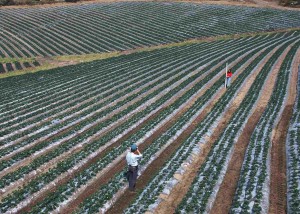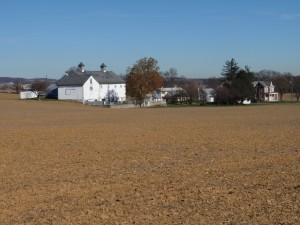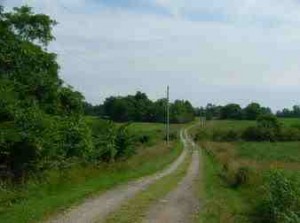CA superior court rules in favor of farmland mitigation
BY DEBORAH BOWERS, Editor & Publisher
FRESNO, CA – California’s Fifth District Appellate Court ruled Nov. 29 that the Stanislaus County Farmland Mitigation Program (FMP) does not conflict with state law or exceed the county’s police power, claims made by the Building Industry Association of Central California. The program will stand, and developers will continue to be required to provide for preservation of an acre of farmland for every acre their projects convert. The California Farm Bureau Federation and others were interveners in support of the county. Click here to view the ruling.
For development proposals converting 20 or fewer acres, the Stanislaus County program allows for either direct acquisition of a conservation easement on comparable lands, or the purchase of banked credits. If a developer of a parcel of fewer than 20 acres can demonstrate that no comparable land was available for conservation easement and no credits were available, a fee in lieu of purchase can be paid. But for parcels of greater than 20 acres, purchase of a conservation easement on comparable lands is required. The developer is solely responsible for negotiating and settling the easement purchase.
It is estimated that about 10 localities in California have enacted farmland mitigation programs.
A lower court found that Stanislaus County and the intervening Farm Bureau Federation failed to demonstrate a “reasonable relationship” between the FMP’s requirements and the negative impact of converting agricultural land to residential use. The lower court additionally found the county failed to show the FMP’s mandates would or could achieve its “ostensible purpose of mitigating farmland conversion.”
The appellate court found however, “that contrary to the trial court’s conclusion, the FMP mandates bear a reasonable relationship to the loss of farmland to residential development. As outlined in the County’s updated agricultural element, agriculture is the leading industry in the County generating an annual gross agricultural value in excess of a billion dollars into the local economy. Further, the elements that make the County so well suited for agriculture, i.e., favorable climate, flat land, available water and low-cost power, also make the County attractive for urban development, including affordable housing within commuting distance of major employment centers.”
The Building Industry Association claimed the farmland mitigation program was “arbitrary and without evidentiary support.” The appellate court disagreed, finding that, “Agriculture is the County’s leading industry. Real estate development that requires agricultural land to be converted to residential use has a deleterious impact on this valuable resource. Although the developed farmland is not replaced, an equivalent area of comparable farmland is permanently protected from a similar fate. To meet the reasonable relationship standard it is not necessary to fully offset the loss. The additional protection of farmland that could otherwise soon be lost to residential development promotes the County’s stated objective to conserve agricultural land for agricultural uses.”
NEWS BRIEFS
In Pennsylvania …The state board approved 1,916 acres for preservation Dec. 9. The 23 farms involved are located in 10 counties. Nine of the farms are located in Lancaster County and range in size from a 46-acre crop farm to a 139-acre
dairy. Three of the farms are in Berks County. Lancaster and Berks are among the nation’s top 12 local programs for number of acres preserved
(see FPR Sept. 2010 Edition). Chester County, another of the nation’s Top 12, had one farm in this month’s approvals. Pa. now has 4,096 farms and 444,647 acres preserved, the nation’s highest number of acres preserved in a purchase of development rights (PDR) program.
Since 1988, state, county, township and federal programs have spent more than $1 billion on farmland preservation. The state alone has spent $337 million.
In West Virginia… Since 2002, Jefferson County has been collecting a local transfer tax to fund its farmland preservation program. This month, despite drastic reductions in that funding due to scanty real estate transfers, the county had enough funds to preserve 668 acres on seven farms, bringing the county’s total preserved farm acres to about 3,000. There are now 32 farms with conservation easements in the county. One-third of the local transfer tax goes to the program. About five years ago the annual revenue to the program was over $1 million. Now it is about $360,000, according to the county farmland protection board. About 17 counties in the state have enacted local transfer taxes to pay for farmland presewrvation.
In Maryland… Howard County has produced bumper magnets to give out to farmland preservation supporters. The 3-inch by 12-inch “Farmland Forever” is illuminated against a farmland scene. “It gives me great pleasure to make the
Farmland Forever bumper magnets available to the public,” said County Executive Ken Ulman. “It is a wonderful way for the public to show its support of the landowners who are preserving their farmland for future generations and helping us protect the quality of life in Howard County for future generations.” The program also produces a Farmland Forever roadside sign for preserved farms, as do many Maryland counties. Howard County has preserved about 21,000 acres of farmland. It was the first locality in the nation to offer payments in tax free installments. The program was inactive for a number of years during the real estate boom. Its location in the urbanizing corridor between Baltimore and Washington and the absence of agricultural protection zoning has made land protection a particular challenge.
Preserving farmland in Corn Country
BY TOM DANIELS, Senior Contributing Editor
Clark County, Ohio lies on the eastern edge of America’s great Midwestern Corn Belt. Tucked between the cities of Dayton and Columbus, more than 80 percent of the county—about 177,000 acres—is devoted to farming. The county’s population of 144,000 is expected to hold steady for the near future. In 2007, Clark County farmers produced $137 million in farm products, including 11.7 million bushels of corn. Compared to the East, this is big farm country, with more than half of the county’s farmland in ownerships of 1,000 or more acres.
With more than 10,000 acres preserved, Clark County is also the leading county in farmland preservation not only in Ohio, but in the Midwest, where farmland preservation is only operating at the state level in Ohio, Wisconsin and Michigan.
From 2002 to 2007, Ohio saw 618,000 acres leave farming. Fortunately, in 2002, the state launched a farmland preservation program that has preserved slightly more than 42,000 acres so far. In 2008, the state program received $35 million from the Clean Ohio bond, but that money is slated to run out in 2012.
Interest from Ohio farmers has far exceeded the available funding. In May of this year, farmers submitted easement sale applications on 203 farms. But the state only had money for 37 offers. Also, because of the strong demand for easement sales, the state has set a minimum threshold of 60 percent donation of easement value. That may seem like a high donation percentage, but as one farmer remarked to me, “There are a lot of farmers with tax problems.” Tax problems means they have high incomes this year from a combination of good yields and a corn price above $5 a bushel. A bargain sale of part cash and part donation could put cash in a farmer’s pocket and help reduce the federal income tax bite.
A major obstacle in the Midwest has been a shortage of county-level funding. In Ohio, for example, a farmland preservation ballot failed in Wayne County, Ohio in 2004. The Clark County Commissioners have given some funding for farmland preservation, but less than $100,000 and there is no dedicated funding source. Federal Farm and Ranchland Protection Program funds have been an important source of public money.
Clark County’s farmland preservation effort has been coordinated through the Tecumseh Land Trust. Krista Magaw is the Executive Director of the Tecumseh Land Trust, founded in 1990 and the first land trust in Ohio to receive accreditation from the Land Trust Alliance. The Trust has preserved more than 17,000 acres of farmland and natural areas in Clark, Greene, and Clinton Counties. Magaw is a member of the Clark County Farmland Preservation Workgroup which has conducted surveys indicating strong support for a county farmland preservation program. But the drastic cuts in local government and the continued sluggish economy do not bode well for funding a new county farmland preservation program. That’s why the Tecumseh Land Trust will continue to play a key role in keeping Clark County’s farmland preservation momentum going. An innovative program the Trust has created is to get local business owners to contribute one percent of their revenues to the Trust’s land preservation efforts.
Contact: Krista Magaw: krista@tecumsehlandtrust.org (937) 767-9490.
Tom Daniels is professor of planning at the University of Pennsylvania, Dept. of City & Regional Planning.
The gift that keeps on giving – three times a day!
BY MIKE MCGRATH, Contributing Editor
At this time of year our thoughts turn to gifts. Hopefully, we are all thinking about the “spirit of giving.” But, it’s easy to fall into the commercialization of the holidays. We might even become somewhat greedy as we draft up another gift list to drop hints to friends and family. But let’s pause for a minute in the rush and draw up a gift list for farmland preservation – in the “spirit of giving.”
Extension of favorable treatment for donations and bargain sales of conservation easements. There’s little doubt that this law (while it lasted!) had a huge impact on preservation. In Delaware it meant many more applications for ag districts came in and much more aggressive discounting by prospective easement sellers. In effect, the landowners knew that they would be getting some of that discount back in the form of lower taxes in future years. It saved Delaware and our funding partners a lot of money and allowed us to preserve many more acres of prime farmland with limited resources. Congress can give a great big gift to preservation by extending the higher deductibility and longer carry-forward period for taxpayers who care about preservation – and give up a lot to see it happen.
Legislative leaders who understand that land preservation lowers the cost of government. Well, you can never have too many of those! Educating, and then convincing, legislators of the wisdom of land preservation can be excruciatingly slow work. But in the long run it is one of the strongest arguments for spending money on preservation – saving money in the long run. As more and more land gets permanently preserved our high costs for sprawl development will stop skyrocketing. Just another way that land preservation is the gift that keeps on giving. Maybe a few of these legislators will be under your tree!
Shoppers looking for local food. As this trend has accelerated it has meant more support for preservation. We need more of those folks. It’s local food that tastes better, that lowers our carbon footprint and supports the local economy. And our fellow citizens are beginning to realize that these benefits depend on local land remaining in farming. And citizens “get it.” Our surveying of public opinion in Delaware over the years has shown that taxpayers put “local food supply” at the top of the list when it comes to the reasons they support farmland preservation. Right up there, too, in citizen recognition are the economic benefits of agriculture. In Delaware we have seen steady gains in vegetable acreage as one indicator of the farm sector response to changing eating habits. If we could receive some more local food shoppers under our tree . . . well, so much the better!
Optimism in agriculture. We constantly need to replenish our optimism. And optimism is truly a “gift.” The good news is that most farmers come equipped with an abundance of this otherwise scarce commodity. I’ve been amazed my whole life by the farmer’s optimism demonstrated each year at planting time. No matter how tough the years have been it seems that the warm sun of spring and a bag of seed rejuvenates the farmer’s enthusiasm for taking another stab at that “perfect year.” My father was a great example of that. Late in his life we celebrated his birthday and 70 years farming. That’s right – 70 years of bringing in crops. He had a tough childhood in that at 11 years old, he and his older brother, just 18 himself, took over the farm due to my grandfather’s failed health. But he loved farming and never looked back. Being from upstate New York he had a somewhat gruff demeanor, but a subtle sense of humor. At his party someone asked Dad about his experience as a farmer for 70 years. He paused just slightly and said, “Well, I think in that 70 years I had two good years!” Well, the room exploded in laughter! When the noise died down Dad said, with a twinkle in his eye, “No, wait a minute – one good year!” Like most farmers, Dad had experienced good years and bad years. But he was, with good humor, an optimist through it all. And we know that landowners’ attitudes about the future of agriculture are the main determinant of their decisions to preserve land. “Lord, please send us some more optimism this year.”
Abolition of estate taxes on agricultural land. Well, I always say – think BIG when you write up your gift list! We all do it – put something on that list which our heart desires but that we know is – maybe – just too big to really expect. There is not another single thing that would preserve as much land from development as ending the estate tax on ag land. And, in my opinion, it’s a no-brainer. What’s fair about charging every generation huge taxes just to receive the land of their ancestors and allow them the privilege of pouring money into it in order to farm for little return? And will this solve the Federal deficit? Not by a long shot! Estate taxes on farm land are but a “blip” on the U.S. Revenue screen. But it means so much to the farm families, especially where land values are high, that often must mortgage the place just to keep what their parents worked a lifetime to acquire. If this big box appears under the tree – well, it will have been a good year!
Now, that’s my gift list for farmland preservation this year. Of course, yours may be different. Some of the same things perhaps – and others that are important to you. But farmland preservation has given so much – to all of us – that, well, every gift on the list is well-deserved. As we sit down to holiday meals around tables with family and friends may we give thanks for the bounty we share and those in agriculture who bring it to us. Is it too much to give in return by making the “preservation gift list” a reality? I know each of you are doing your part and may you be blessed in your efforts, have a happy holiday season and a prosperous New Year!
Mike McGrath is director of the Delaware Agricultural Lands Preservation Foundation.



